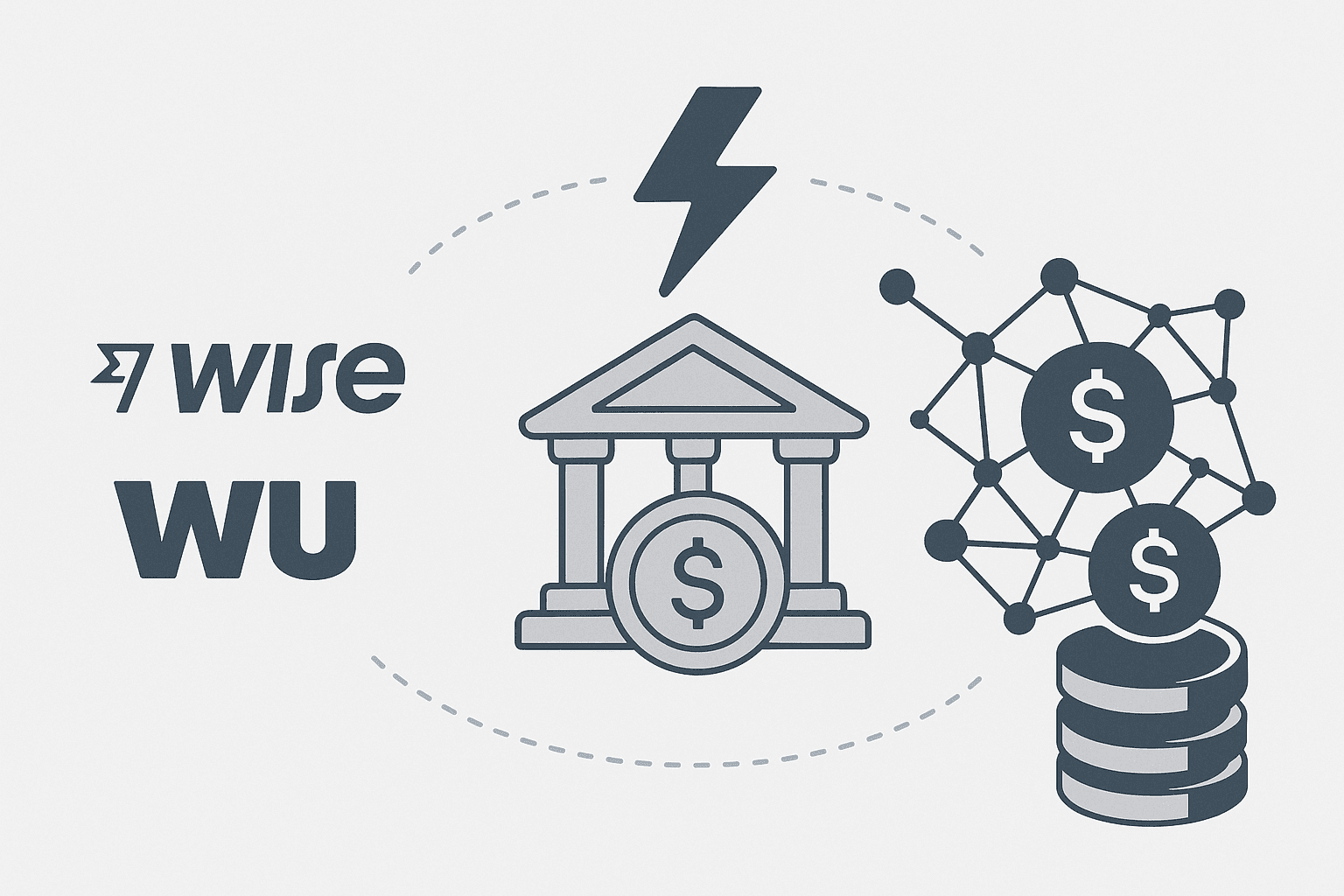The cross-border payments industry faces its most significant disruption since the digital revolution. Traditional remittance leaders like Western Union and fintech disruptors including Wise are confronting an unprecedented challenge: institutional stablecoin adoption by major corporations and financial institutions. With groundbreaking regulatory frameworks like the GENIUS Act and corporate giants entering the crypto payments space, the competitive landscape is experiencing fundamental transformation.
The Data Reveals Traditional Remittance Decline
Recent market analysis exposes a stark reality for legacy payment providers. According to VanEck's Head of Digital Assets Research, Matthew Sigel, Western Union witnessed a 22% decline in app downloads while MoneyGram suffered a 27% reduction in user acquisition. More concerning for these established players: their monthly active users remain stagnant below 3 million since 2021.
Simultaneously, the stablecoin market has exploded to over $250 billion in total market capitalization, with approximately 99% of these digital assets pegged to the U.S. dollar. This represents a seismic shift in how businesses and consumers approach crypto treasury management and stablecoin business accounts.
Stablecoin Payment Adoption Accelerating Globally
A February 2025 survey of U.S. adults engaged in cross-border remittance activities revealed that 26% had used stablecoins for international transfers within the previous year. This adoption rate represents exponential growth from earlier periods, demonstrating the crypto payment adoption by banks and individual users alike.
The appeal extends beyond consumer adoption. Stablecoin payment volume has reached unprecedented levels, with platforms offering high yield business bank account crypto solutions attracting significant enterprise interest.
Corporate Stablecoin Revolution: Amazon and Walmart Lead the Charge
The most transformative development threatening traditional payment processors involves corporate stablecoin initiatives by retail giants. Amazon and Walmart are reportedly exploring stablecoin business accounts and corporate digital currency issuance, potentially eliminating billions in annual credit card processing fees.
Market Impact on Payment Networks
Following reports of Amazon and Walmart's stablecoin exploration, payment stocks experienced significant volatility:
Visa shares dropped 5%
Mastercard declined 4%
Traditional payment processors faced market pressure
The financial implications are staggering. Federal Reserve data indicates approximately $32 billion in total interchange fees on prepaid and debit transactions alone in 2021, with rapid growth continuing. For corporations like Amazon and Walmart, these fees represent billions in annual expenses that stablecoin payment processors could eliminate.
Corporate Treasury Benefits
Amazon's annual revenue of $638 billion and Walmart's $122 billion in net sales demonstrate the scale of potential stablecoin transaction volume. These retailers recognize that crypto cash management for businesses offers substantial cost advantages over traditional payment rails.
GENIUS Act: Regulatory Framework Enables Institutional Adoption
The regulatory environment that previously hindered institutional stablecoin adoption is rapidly evolving. The U.S. Senate passed the GENIUS Act (Guiding and Establishing National Innovation for U.S. Stablecoins Act) with a decisive 68-30 vote, establishing the first comprehensive federal framework for stablecoin regulations.
Key GENIUS Act Provisions
The legislation establishes groundbreaking requirements for stablecoin treasury strategy:
Full reserve backing with 1:1 asset ratios
Monthly audits and transparency disclosures
Anti-money laundering compliance standards
Clear licensing pathways for institutional issuers
Treasury Secretary Scott Bessent projects the U.S. stablecoin market could grow eightfold to over $2 trillion in coming years, driven by this regulatory clarity.
Stablecoin Infrastructure Advantages Over Legacy Systems
Settlement Speed Revolution
Traditional remittance services, including digitally-focused providers like Wise, rely on legacy banking infrastructure requiring multi-day settlement periods. Stablecoin infrastructure enables instant settlement in seconds with superior transaction finality.
Cost Structure Transformation
Zero fee payment processor crypto solutions eliminate the substantial fees and exchange rate markups that burden traditional services. While Western Union and Wise charge significant transaction fees, stablecoin payment systems operate for fractions of pennies on efficient blockchain networks like Solana.
Global Accessibility Without Infrastructure
Unlike traditional services requiring extensive agent networks or banking partnerships, programmable yield stablecoin systems operate on global, permissionless networks. Any entity with internet access can participate, eliminating physical infrastructure requirements in target markets.
DeFi Integration Benefits
Perhaps most significantly, stablecoin yield infrastructure enables programmable money features impossible with traditional rails:
Automated yield generation on idle funds
Conditional payment logic for complex business workflows
Smart contract functionality creating entirely new business models
Real-time treasury optimization
Banking Industry Embraces Stablecoin Innovation
Institutional adoption extends beyond retailers. JPMorgan Chase filed a trademark application for "JPMD," indicating stablecoin product development. Major financial institutions including Bank of America, Citigroup, and Wells Fargo have reportedly discussed joint stablecoin initiatives.
Bank CEO Statements Signal Industry Shift
Bank of America's CEO confirmed at a Morgan Stanley conference that the institution is actively exploring stablecoin issuance. When major banks pivot toward stablecoin development rather than competing against crypto payments, the implications for traditional remittance services become clear.
Network Effects Drive Stablecoin Adoption
Stablecoin adoption 2025 benefits from powerful network effects unavailable to traditional payment systems. As more institutions implement crypto mobile payments, liquidity improves, costs decrease, and utility expands exponentially.
Major Platform Integration
Stripe, the second-largest online payments processor, now enables USDC payments for U.S. merchants. PayPal announced 3.7% interest for users holding PayPal USD in digital wallets. Shopify confirmed USDC payment integration before year-end 2025.
This creates a flywheel effect where each new participant increases network value for all users - impossible with traditional closed-loop payment systems.
Real-World Implementation: Beyond Theoretical Benefits
Corporate stablecoin implementation moves beyond speculation into active deployment. Companies are implementing business defi solutions today, demonstrating practical advantages over traditional payment processors.
Programmable Payment Infrastructure
For businesses implementing stablecoin payment systems, platforms like RebelFi pioneer the integration of programmable payment features with DeFi yield generation. By combining instant settlement with automatic yield optimization, these solutions demonstrate how crypto treasury management delivers superior economics compared to traditional payment rails.
RebelFi's innovative approach transforms every business transaction into a revenue-generating opportunity rather than a simple settlement event. This programmable yield methodology exemplifies how embedded defi solutions create competitive advantages impossible with legacy payment infrastructure.
Traditional Payment Provider Response Strategies
Legacy players attempt responding to the stablecoin threat through limited digital initiatives. MoneyGram enabled Stellar USDC for on/off ramps, but these efforts appear reactive rather than transformative.
Fundamental Business Model Challenges
The core challenge for companies like Western Union and Wise involves business models built around friction that stablecoins eliminate entirely:
Western Union's agent network becomes a cost burden when customers send money instantly without intermediaries
Wise's currency matching system becomes obsolete with global liquidity pools enabling instant settlement
Traditional FX spreads disappear with transparent, market-rate currency conversion
Business Impact: Competitive Advantages for Early Adopters
Forward-thinking businesses implementing stablecoin business accounts gain significant advantages:
Cost Optimization
Eliminating interchange fees and reducing settlement timeframes directly improves cash flow and profitability margins.
Global Market Access
Stablecoin infrastructure enables businesses to accept USDC payments from anywhere globally without establishing local banking partnerships.
Advanced Financial Features
Smart contract capabilities enable innovative business models including:
Yield-generating escrow accounts
Conditional payment triggers
Automated treasury management systems
Programmable subscription billing
Competitive Market Position
Early adopters gain cost structure and operational efficiency advantages that traditional payment users cannot match through legacy infrastructure.
Future Outlook: Inevitable Industry Transformation
The evidence supporting institutional stablecoin adoption is overwhelming. With regulatory clarity from the GENIUS Act, corporate giants exploring stablecoin issuance, and major banks developing proprietary offerings, traditional payment landscapes face fundamental disruption.
The Mathematical Advantage
For Western Union and Wise, the challenge transcends competing on fees or processing speed—it involves competing against a paradigm shift toward programmable, yield-generating, instant-settlement money. When transactions cost pennies instead of percentage points, settle instantly rather than requiring business days, and generate yield instead of remaining idle, competitive gaps become mathematically unbridgeable.
Strategic Adaptation Requirements
Companies recognizing this transformation early and adapting business models accordingly will survive market disruption. Organizations failing to embrace programmable money risk becoming obsolete in an increasingly digital financial ecosystem.
Conclusion: The Programmable Money Revolution
Institutional stablecoin adoption represents more than market disruption, it constitutes a fundamental shift toward programmable financial infrastructure. The combination of regulatory clarity, corporate adoption, and technological advancement creates an unstoppable force transforming global payments.
The future of business payments is programmable, instant, and yield-generating. Traditional remittance services built on legacy infrastructure cannot compete with stablecoin advantages offering superior economics, faster settlement, and innovative financial features.
The question facing payment industry stakeholders isn't whether stablecoins will disrupt traditional services, it's determining how rapidly this transformation will occur and which organizations will successfully adapt to the programmable money economy.
Ready to explore how stablecoins can transform your business payments? Discover how RebelFi combines instant settlement with automatic yield generation, turning every transaction into a profit opportunity through our innovative embedded DeFi platform.



